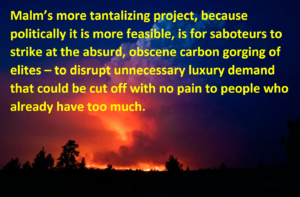It’s not often you hear the New York Times opining on the value of industrial sabotage, yet columnist Ezra Klein last week did just that, posting a column that began: “I spent the weekend reading a book I wasn’t entirely comfortable being seen with in public. Andreas Malm’s ‘How to Blow Up a Pipeline’ is only slightly inaptly named. You won’t find, anywhere inside, instructions on sabotaging energy infrastructure. A truer title would be ‘Why to Blow Up a Pipeline.’ On this, Malm’s case is straightforward: Because nothing else has worked.”

Ahr valley town of Bad Neuenahr-Ahrweiler, Germany, July 16, 2021, hours after Ezra Klein’s NYT post went up. Image from video by @AnthonyQuintano.
Malm makes the case for grassroots-organized destruction of the property of energy companies to raise the cost of their doing business and to punish fossil investors. More importantly, he advocates also for sabotage of the property of the very wealthy, whose outsize carbon footprint adds extra layers of class-based culpability in the unfolding crimes against humanity which climate change already constitutes, not in some hazy future but today.
Klein, however, cannot abide property destruction, and therefore Malm is dismissed, from the pulpit of the Times to all the listening world, as “trying to make eco-terrorism a thing.”
So what’s the news here? New York Times opinion columnist not comfortable being seen with book that advocates blowing sh** up? Klein is only comfortable enough to make sure the book is shrugged off and no one bothers to read it. That’s a grave public disservice at a time when the status quo is untenable, when business-as-usual -– a heedless headlong plunge toward catastrophe -– demands demolition.
To his credit, Malm, an author and professor at Lund University in Sweden, recognizes the limits but also the absolute need of radicalism to meet an ecological crisis that over the long term will likely be an existential one for industrial Homo sapiens: “The question is not if sabotage from a militant wing of the climate movement will solve the crisis on its own –- clearly a pipe dream –- but if the disruptive commotion necessary for shaking business-as-usual out of the ruts can come about without it. It would seem foolhardy to trust in its absence and stick to tactics for normal times.”
Look again at the history of well-intentioned, sometimes visionary people sticking to tactics for normal times and having no effect on carbon emissions. It is indeed distressingly accurate that nothing has worked: Not endless meetings at COPs 1 through 25 (maybe something will happen at meetings 26 through 50); not the IPCC’s increasingly panicked reports of warming to come and warming already here; not Greta Thunberg’s agonized despair, and not the schoolchildren by the millions abandoning class to follow her lead; not Bill McKibben’s earnest plodding entreaties; not the shutdowns of London by the massed peaceful disrupters of Extinction Rebellion (XR); not the broader peaceful protests inspired by XR and others during 2019, before COVID cancelled crowds everywhere; not endless entreaties to a swing-vote U.S. senator who, The Guardian revealed the other day, owns millions in coal stocks; not the known and accepted fact that we are now headed for a 3ᵒC-degree warmed world, which will produce terrestrial hellscapes with dire consequences for global society, starting with mass migrations and moving into mass die-offs.
No, emissions continue to rise, the climate continues to fracture, while ecosystems, whose pillage is separate but related to the saturation of the carbon sink, spiral into chaotic dissolution and the silences of extirpated and probably soon to be extinguished species.
The hour is late, the window for action is closing. What’s needed is widespread disruption of the intolerable status quo. So what kind and how much?
For Malm, nothing is off the table.

Verso Books, Brooklyn, NY (2021).
It is a “virtue,” he writes, that groups like XR and others such as Germany-based Ende Gelände (“This far and no further”) commit to non-violent civil disobedience to challenge business-as-usual “by means of ever bigger, bolder mass actions.”
“Let a hundred Ende Gelände camps bloom and fossil capital might find itself under some real pressure,” Malm enthuses. But his interrogation of the climate movement asks us to go beyond absolute nonviolence as “forever the sole admissible tactic in the struggle to abolish fossil fuels.”
In marshaling the argument for ecosabotage in defense of a ecologically healthy liveable earth, Malm quotes British novelist and essayist John Lanchester on the matter of defacing automotive grotesqueries:
In cities, SUVs are loathed by everyone except the people who drive them; and in a city the size of London, a few dozen people could in a short space of time make the ownership of these cars effectively impossible, just by running keys down the side of them, at a cost to the owner of several thousand pounds a time. Say fifty people vandalising four cars each every night for a month: six thousand trashed SUVs in a month and the Chelsea tractors would soon be disappearing from our streets. So why don’t these things happen?
Lanchester wondered then, in 2007, if it was because “people who feel strongly about climate change are simply too nice, too educated, to do anything of the sort.” And then circles the target, asking if it’s because “even the people who feel most strongly about climate change on some level can’t quite bring themselves to believe in it.” To which we can add that in a society in which the dominant mindset declares inanimate objects to be sacred totems, you face a lot of trouble when you dare to deface them.
**
Consider the example of the strong feelings of the suffragettes of England, whose ferocity against inanimate objects is inspiration to Malm. “Militancy was at the core of suffragette identity,” he writes, and at the core of militancy was property destruction. Emmeline Pankhurst, co-founder of the Women’s Social and Political Union, specialized in the “argument of the broken pane,” sending her enraged crews of well-dressed women into central London, bringing it to a standstill as they shattered the storefronts of dozens of businesses – jewelers, silversmiths, toy shops – and elsewhere attacked statues and paintings with hammers and axes. They planted bombs, fought policemen in street melees.
“Such deeds,” observes Malm, “went hand in hand with mass mobilization… The suffragettes [deployed] the gamut of non-violent and militant action.” After 1913, following defeat of legislation in England to give them the vote, they engaged in “a systematic campaign of arson,” burning or blowing up “villas, tea pavilions, boathouses, hotels, haystacks, churches, post offices, aqueducts, theatres…” They burned cars and sank yachts. Over the course of a year and a half, the WSPU lay claim to at least 337 attacks.
According to Malm, no lives were lost, as the suffragettes “took great pains to avoid injuring people.” Pankhurst considered the situation so urgent – the need for women to have the vote so important – that “we had to discredit the Government and Parliament in the eyes of the world; we had to spoil English sports, hurt businesses, destroy valuable property… upset the whole orderly conduct of life.”

Pic by John Hendricks, Oregon Office of State Fire Marshal, July 17, 2021 via Associated Press, courtesy New York Times.
A problem with upsetting the orderly conduct of life with attacks on fossil fuel infrastructure in the developed world – one of the two prongs of sabotage that Malm advocates – is that it threatens to disproportionately punish those who can least afford it: poor and middle class fuel oil and gasoline consumers.
This was one of the main objections from Ezra Klein, who noted, not incorrectly, that “the consequence of a wave of bombings to obliterate energy infrastructure would be to raise the price on energy immediately [and] the burdens would fall heaviest on the poor.” (Higher energy prices from a carbon tax whose revenues are returned to the neediest and hardest hit as a dividend is a different story -– the telling of which is a raison d’être of the Carbon Tax Center.)
I suggest that Malm’s more tantalizing project, because politically it is more feasible, is for saboteurs to strike at the absurd, obscene carbon gorging of elites -– to disrupt unnecessary luxury demand that could be cut off with no pain to people who already have too much. “If we have to cut emissions now,” he argues, “we have to start with the rich.”
Malm cites the pivotal distinction, formulated by philosopher Henry Shue, between luxury and subsistence emissions: “The former happen because rich people like to wallow in the pleasure of their rank, the latter because poor people try to survive.” Peasants in India using coal to cook bread or at night getting the dim light from a dying bulb fed by a coal-fired power plant are confined in their choices because the alternative for poor people locked in the fossil economy, as Malm bluntly explains, “might be no stove and no lamp.”
The rich man on his yacht, on the other hand, has the opportunity to scrap the yacht and cease his profligacy and waste, but chooses not to. This wanton disregard is aggravated by the fact that the hypermobility of the rich “is what frees them from having to bother with the consequences, as they can always shift to safer locations. To be super-rich and hypermobile above 400 ppm,” Malm notes, “is to dump lethal hazards on others and get away from them in one master stroke.”
As it happens, we have data on the carbon footprint of the global fleet of 300 superyachts, defined as boats longer than 24 metres and affordable only to an estimated 0.0027 percent of humanity. In a single year, the fleet generates as much CO2 as the ten million inhabitants of Burundi.
Somewhat more broadly, the richest one percent of the world’s people were responsible for 15 percent of the emissions added to the atmosphere between 1990 and 2015, according to Oxfam’s Confronting Carbon Inequality report released last year. To be superrich is to have the yacht, of course, and luxury cars with gas-guzzling engines, and multiple SUVs, and mansions in multiple countries, and jets, helicopters, sometimes private airports, sometimes private submarines. Malm declares them all targets ripe for sabotage. And because of their outsize footprint, destruction of rich people’s property isn’t just symbolic – though symbolism matters, of course. (Add to the target list, for example, the space vehicles of Bezos-Branson-Musk that merely announce how wondrous it is that elites are capable of wallowing in rank outside our atmosphere as much as in it.)

NYC subway entrance, July 8, 2021, during a 30-day period with over 10″ of rain, a record. Image from video by @PaulleeWR.
The most important symbolism in attacking carbon entitlement is in the context of any attempt by the rest of society at decarbonization. Luxury emissions, writes Malm, “represent the ideological spear of business-as-usual, not only maintaining but actively championing the most unsustainable kinds of consumption….Consumption in middling strata is patterned on it, the nouveau riche across the world scrambling to join the 0.0027 per cent.” It’s Thorstein Veblen’s dynamic of pecuniary emulation -– conspicuous display of luxury emissions leads to more emissions by others as display –- but writ on a global scale with the ultimate cost that the poorest members of humanity are flooded, drowned, starved, or burned out. Luxury emissions conspicuously displayed are at the same time “supremely demoralizing for mitigation efforts.” Here’s Malm:
Merely catching sight of a superyacht gliding through the estuary, or hearing about the latest record in private tower construction, or reading about the still-soaring sales figures for the most gas-guzzling cars on the market is enough to break anyone’s hope that we will ever bend the curve. If we cannot even get rid of the most preposterously unnecessary emissions, how are we going to begin moving towards zero? [emphasis original]
But then there’s the question of who is best situated to commit acts of property destruction? As a journalist, I’ve gotten to know a number of ecosaboteurs. I count them among my heroes because they had guts and daring, went out mostly alone into situations of terrible precarity, acted as their conscience directed them, hurt no living beings but wrecked a lot of property and cost millions to the corporations who owned the property.
They believed that as they acted, others would be inspired to join them. But this didn’t happen. Every one of these people ended up caught by authorities hell-bent on punishing the heinous offenders against the inanimate objects called property. They did time in state and federal cages. As of this writing, one of them sits in his cage at the tail end of nine years in the federal prison system for attempting, as he put it, to “end global warming” by attacking the “fossil fuel infrastructure system.”
As Lanchester described, the need is for a critical mass of saboteurs willing to take the risk. Malm’s book is a first attempt (there will be more soon, I expect) to rally citizens to that end. The key is that lots of people have to do it, at the same time, in numbers such as have never been seen. But let’s not soft-pedal, as I think Malm does, the crushing consequences of getting caught in acts of sabotage, the weight of the carceral state as it comes down on your head in a manner outrageously disproportionate to the damage you inflict on the system of protecting inanimate objects.
Things are worse today than in the age of the suffragettes –- property is more sacrosanct than ever. Your own life will be ruined if you even moderately violate that sacred realm. You will go to jail. You will be bankrupted with court costs and fees and fines of restitution. Your children will suffer, as they effectively lose a parent. Such heroism and sacrifice has to be mean something, and it won’t mean a thing if it’s not widely supported and emulated.
Christopher Ketcham is a free-lance journalist and author of This Land: How Cowboys, Capitalism, and Corruption Are Ruining the American West (Penguin Random House). He may be reached at christopher.ketcham99@gmail.com.

Lorna Salzman says
Ketcham has proposed, theoretically, a commensurately radical solution to a dire global emergency. But it presupposes that there is a sufficient critical mass of people who are angry enough to carry it out. The problem will not be solved by government, that much is certain. But to assume that enough people will initiate a sufficient commensurate solution is as much a fantasy as imaging that governments (especially ours) will take commensurate action. The reason for this is simple: elected officials don’t lead, they follow. And they only follow when they are convinced that their action will not harm their career or that of the institutions they represent or rely on. Thus, it is up to citizens to initiate and implement a response. So why haven’t they? Not because they don’t believe in climate change or its consequences; it is because their pocketbooks come first. This is not a simplistic answer. Any look at the public discussion of any issue, environmental or otherwise, boils down to money. And it isn’t just the rich who want to stay rich. It is the middle class, the educated class, the consuming class, that puts it first. They put it ahead of health, education, public safety, culture, social and economic justice, crime. If someone disputes this, please provide your supporting evidence. They won’t even pay a dollar more per gallon for gasoline, even as they splurge on cigarettes, Coca Cola, cruise ship vacations, golf, sports tournaments, international plane travel, costly sports shoes, massages, nail salons, hairdressers, private schools, endless electronics. Overconsumption, they say? Frivolities? No way. This is the AMERICAN WAY. And Ketcham (and others) really expect that consumers will respond to well justified ecotage? If they wont respond to legal, measured moderate forms of governance and self-control, does he really think that the acts of
sabotaging the destructive machines of capitalism and weakening the roots of capitalism consumerism are in our future? Not a chance. Note: history and economics tell us that in fact ONLY money will solve the problem of climate change. As others have said, if you want less of something you make it more expensive. Those “progressives” and leftists who have strangled a carbon tax in its cradle never learned this lesson. They are neither reformers nor radicals; they have bought into the whole consumer economic growth model without hesitation. Will a solution be found? No, it won’t be found.It will descend upon us heavily, painfully and randomly as the whole system starts to lose air and collapse. The first place this happens will be with food supplies, dependent on healthy soil and freshwater, which is disappearing rapidly. The second will be in ecosystem collapse as the insect population continues its downward plunge. The next will be disease, as tropical insect vectors continue making their way north.
Etc, etc. Finish the list as you please. But dont count on the public or government. They are both too busy finding excuses to do something they think is more important than the survival of civilization (ending poverty and racism are the favorites now).
Dave Foreman says
Hey, I wrote a much more comprehensive book–Ecodefense: A Field Guide to Monkeywrenching–back in 1985. Shucks. People just don’t know history anymore.
Christopher Ketcham says
Yes, and I have it on my shelf and consider it one of the greats. I wasn’t reviewing Ecodefense, alas…
Chris Zinda says
And, look how you and Wolke turned out, Dave. Certainly not vocational at the art like Roselle.
Peter Jacobsen says
So Klein cannot abide property destruction. How does he feel about the property along that historic German street, which presumably has been standing for half a millennium? What would he say to the property owners in Lytton, BC?